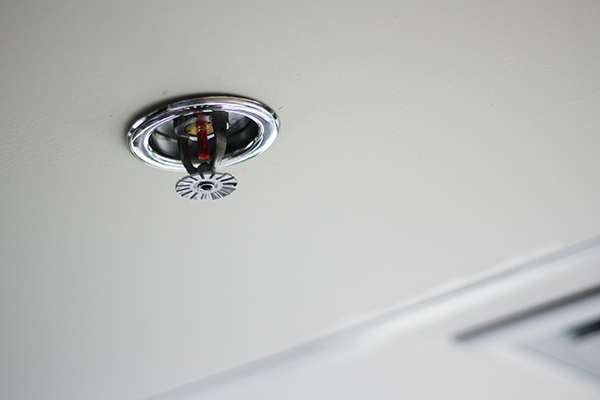Caution urged over partial sprinkler installation
A fire safety expert has urged councils to act carefully if they intend to install sprinklers in tenants’ homes without fitting them in leaseholder properties.
The caution came as one West Midlands local authority insisted social tenants would be “no less safe” if some leaseholders in the same towers declined to install sprinklers.
Tamworth Borough Council has appointed a project manager for a long-awaited scheme to fit sprinkler systems to seven residential blocks in the West Midlands city.
The project, first approved in 2014 but since amended, will now see sprinklers installed in 346 council-owned flats.
After more than 30 leaseholders initially objected to being included in the scheme, a recent council cabinet meeting agreed to allow for “the installation of sprinklers in leasehold flats at no cost to the leaseholder”.
However, the local authority suggested it was willing to leave certain homes out of the project if their leaseholders continued to object.
Michelle Thurgood, cabinet member for housing at Tamworth Borough Council, said: “Our aim is to install sprinklers in all flats, including those of leaseholders who wish to avail of our offer.
“All of our high-rise blocks comply with current safety requirements and regulations, and they are inspected regularly. The sprinklers will provide an additional layer of fire safety.
“The blocks will be no less safe or compliant as a result of some flats not being included, should that be the case, and this has been confirmed by the fire and rescue service.”
But Dr Fathi Tarada, managing director at fire safety consultancy Mosen, said that although partial installation could be effective, there were various general risks for councils to consider before approving it.
“You have to be aware of what you’re getting into,” he said. “If you have two flats adjacent to each other with a compartment wall between them but over the years lots of holes have been drilled in it, then it’s not really functioning as a compartment wall. If you then have a fire in the flat [not protected by a sprinkler system] then that may overwhelm the capacity of the sprinkler in the protected flat.
“If a fire gets too big then sprinklers can become very ineffective; they need to operate very early on to suppress a fire. Experiments show they can be very ineffective at later stages of a fire.”
He added that a blaze could potentially spread through open windows, and added that fire response procedures and advice could be complicated by flats having different levels of protection.
He called for more fire-testing of the effectiveness of partial sprinkler systems.
“I am a great believer in sprinkler systems – with the right compartmentation and management and evacuation responses in place then it’s better to have half a cup than no cup,” he said.
“In some cases partial installation is an option, but I would only recommend it after a full survey and due consideration.”
Tamworth Borough Council hopes to start work installing sprinklers in its towers towards the end of this year.
A Department for Communities and Local Government spokesperson said: “It is for individual building owners to decide what the appropriate fire safety measures are for their buildings informed by guidance from their own professional advisors.”
Inside Housing’s Never Again campaign calls on government to fund the retrofitting of sprinklers in tower blocks across the UK.
Never Again campaign
In the days following the Grenfell Tower fire on 14 June 2017, Inside Housing launched the Never Again campaign to call for immediate action to implement the learning from the Lakanal House fire, and a commitment to act – without delay – on learning from the Grenfell Tower tragedy as it becomes available.
One year on, we have extended the campaign asks in the light of information that has emerged since.
Here are our updated asks:
GOVERNMENT
- Act on the recommendations from Dame Judith Hackitt’s review of building regulations to tower blocks of 18m and higher. Commit to producing a timetable for implementation by autumn 2018, setting out how recommendations that don’t require legislative change can be taken forward without delay
- Follow through on commitments to fully ban combustible materials on high-rise buildings
- Unequivocally ban desktop studies
- Review recommendations and advice given to ministers after the Lakanal House fire and implement necessary changes
- Publish details of all tower blocks with dangerous cladding, insulation and/or external panels and commit to a timeline for remedial works. Provide necessary guidance to landlords to ensure that removal work can begin on all affected private and social residential blocks by the end of 2018. Complete quarterly follow-up checks to ensure that remedial work is completed to the required standard. Checks should not cease until all work is completed.
- Stand by the prime minister’s commitment to fully fund the removal of dangerous cladding
- Fund the retrofitting of sprinkler systems in all tower blocks across the UK (except where there are specific structural reasons not to do so)
- Explore options for requiring remedial works on affected private sector residential tower blocks
LOCAL GOVERNMENT
- Take immediate action to identify privately owned residential tower blocks so that cladding and external panels can be checked
LANDLORDS
- Publish details of the combinations of insulations and cladding materials for all high rise blocks
- Commit to ensuring that removal work begins on all blocks with dangerous materials by the end of 2018 upon receipt of guidance from government
- Publish current fire risk assessments for all high rise blocks (the Information Commissioner has required councils to publish and recommended that housing associations should do the same). Work with peers to share learning from assessments and improve and clarify the risk assessment model.
- Commit to renewing assessments annually and after major repair or cladding work is carried out. Ensure assessments consider the external features of blocks. Always use an appropriate, qualified expert to conduct assessments.
- Review and update evacuation policies and ‘stay put’ advice in the light of risk assessments, and communicate clearly to residents
- Adopt Dame Judith Hackitt’s recommended approach for listening to and addressing tenants’ concerns, with immediate effect
CURRENT SIGNATORIES:
- Chartered Institute of Housing
- G15
- National Federation of ALMOs
- National Housing Federation
- Placeshapers




